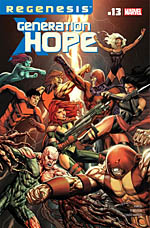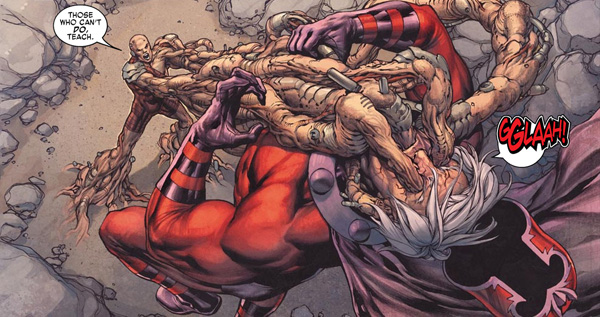 Written by James Asmus
Written by James Asmus
Art by Ibraim Roberson
32 pages, color
Published by Marvel
Generation Hope‘s first twelve issues were, on the whole, a fun little book about a young girl named Hope Summers who is prophesied to be the mutant messiah, as well as a handful of new young mutants whose powers recently manifested. Written by Kieron Gillen, it tied in closely with Uncanny X-Men and rocked out smaller stories that focused much more on character growth than plot-of-the-month. With issue #13, though, the book’s been handed off to James Asmus and Ibraim Roberson, and I can’t help but feel like this book is different enough that it warranted a name change.
The debut issue for Asmus and Roberson has Hope’s squad going up in battle against a handful of X-Men. Presumably it’s to let new readers (coming on board because of the "Regenesis" banner, perhaps) see what the kids can do, but it comes across as a bit blatant and overly standard super-hero. And that, in a nutshell, is the big problem with Generation Hope #13; it feels like any other super-hero title, only a little too blatant. Characters far too often act out of character to make a point (like Magneto ripping Kenji apart without knowing he’d survive), and there’s an almost random level with its plotting. So when we get a new member in the form of Martha Johansson (aka the floating brain from Grant Morrison’s New X-Men run) with no rhyme or reason? Sure, why not.
The most painful part is the dialogue, though, which states things in a way to dole out exposition, but instead just serves to sound awkward. "Every time I use my powers, I’m burning faster and faster into my old age!" It’s clumsily written, and it’s stating a fact to characters who already know it all too well. (The later line about being a teenage boy is even worse, if that’s possible.) The sad thing is that the basic plotting isn’t that bad—the team finding out about Sebastian Shaw but not realizing it’s him—although it does require the Stepford Cuckoos to act a bit more dim than normal for it to happen. And if there’s one thing that almost all of these characters weren’t up until now, it’s dim.

The part that does work is Roberson’s pencils, which are a contrast to past artists on Generation Hope but still feel at home with the title. It’s a smooth, shaded style; I like how Gabriel is starting to look a little older under his pencil, and Kenji’s powers feel that much more grotesque and monstrous when Roberson draws him, an unholy match of man and machine. There’s an energy in his drawings too; when Hope and Teon are running out of the Cerebra room, I actually felt like we could see them in action. And when Noriko looks bored out of her skull while Kenji flirts with Martha, it’s what could be a throw-away moment that just looks awesome.
Generation Hope doesn’t feel at all like its past year, to the point that I’m wondering why (if Marvel likes the concept) they’re sticking with the name. The book’s sales are already rather low, and it might have been smarter to just relaunch the characters into a brand-new book and hope for a sales bump. As it is, I can’t help but feel like #13 might be alienating those who enjoyed the tone of the past twelve issues. This doesn’t feel like a good match of title and creator, and if it lasts for a full second year I’ll be surprised.

One Reply to “Generation Hope #13”
Comments are closed.